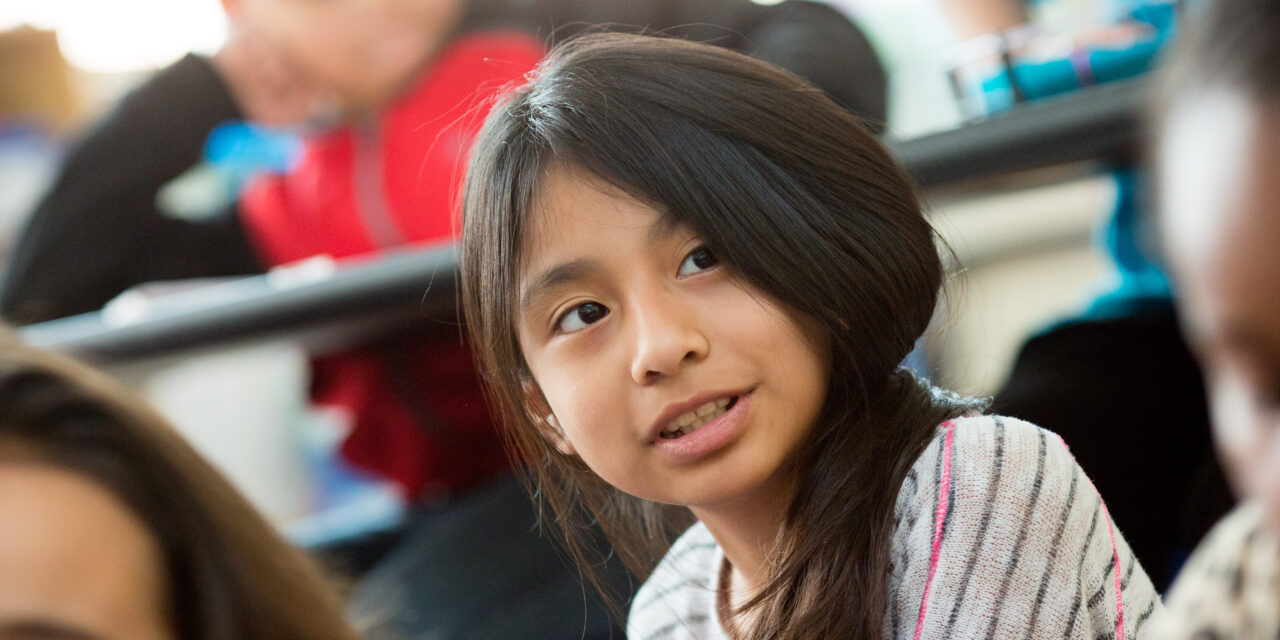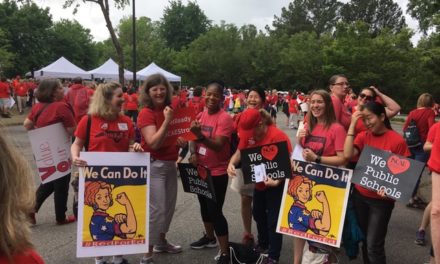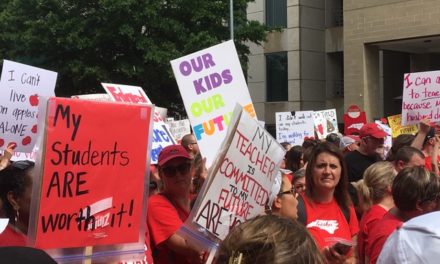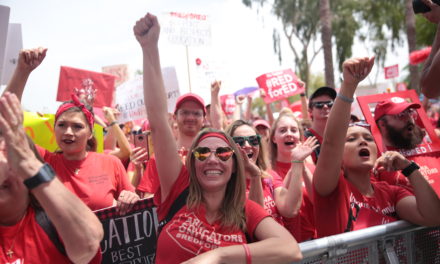Dawn Sydnor Cole, principal at Morrill Math and Science Elementary School in Chicago, has been trying to fill an open position for an art teacher in her school ever since she was first hired to lead the school—six years ago. Why is finding an art teacher for Morrill so difficult?
“Chicago is a city that is very segregated by neighborhoods,” she told Our Schools. “We don’t have a lot of artsy people living in the southwest side of the city—where Morrill is [located]—and a lot of potential teachers are from the north side. I could not attract a teacher to come to our school to teach art because they all want jobs at schools in north Chicago.”
Yet, kids at Morrill have art, music, and dance classes. The students, who are almost all Black and Hispanic and designated low-income, learn choir, put on plays, and make TikTok videos. They have access to a folkloric dance program. After a survey of students showed they were interested in learning about K-pop or Korean pop dance, the school found a way to bring K-pop classes to the school.
“I had never heard of K-pop,” Sydnor Cole said, “and neither had most of our staff. But that’s what the kids were interested in, so we did our research and eventually found a local dance company with instructors who could come after school to teach K-pop. I attended a performance just the other day and the kids were amazing.”
Despite years of not having a full-time art teacher, Morrill students can still learn about the arts because the school, along with 19 other campuses in the Chicago Public Schools (CPS) system, are all in a cohort of what the district and the Chicago Teachers Union (CTU) call “sustainable community schools.”
Being a sustainable community school has been “a big game changer” for Morrill students, Sydnor Cole said.
‘A Hub for Everything’
Richard Yates Elementary School, another Chicago school with mostly Black and Hispanic, and low-income students, has a similar story to tell.
According to Yates principal Israel Perez, because the school also conforms to the sustainable community schools approach, Yates can participate in the Disney Musical in Schools and can perform a different Disney musical every year. “This is something our students had never been able to do,” Perez said.
Through these performances, Perez explained, students learn reading skills because they read scripts and learn about staging and set design. The students learn how to collaborate and work in a team, along with other “soft skills,” according to Perez. “We’ve seen students who were once super shy become the star of a show,” he said.
But being a community school is not just about getting access to arts instruction. “We’ve become a hub for everything, from medical to education to social services,” Perez said.
A medical van stops at the school routinely to give students checkups, vaccines, and other health services. The school provides access to eye doctors and gives free eyeglasses. On weekends, the gym is kept open, and someone is available to teach the students how to play basketball and other sports.
In the summer, students can attend a program that takes them to different communities around the city to learn about different neighborhoods and cultures. They see the city from multiple perspectives and bring their observations back to share with their fellow students. “A lot of our kids have never stepped out of their neighborhood much less left the city,” said Perez.
Parents of students attending Yates get opportunities too. They get assistance with applying for the federal government’s Supplemental Nutrition Assistance Program (SNAP). They get instruction on immigration law and English language learning. One program provides for parents to work with small groups of students to teach them to read.
“Our programs change every year because the offerings are based on the voices of students, parents, and the community,” Perez said. Perez and his colleagues periodically conduct needs assessments—a requirement of the community schools approach—and use the results to drive the school’s programming and services.
‘It’s Not Just About Money’
Funding for CPS’s community schools initiative is a result of a bargain struck between the district and CTU in 2019 to “expand ‘community schools’ that offer wraparound services,” Chalkbeat reported in 2019. As of 2023, campuses with the community schools designation get $500,000 a year to fund their initiatives.
The term “wraparound” refers to any health and social services that are provided in schools, according to the National Education Association, but the community schools approach also includes a shared leadership principle that requires, not only asking families what services they’re interested in but also invites them to be part of the final decision-making.
Rather than burdening schools with more personnel to deliver these services, the community schools approach requires schools to work “[i]n tandem with local nonprofits,” according to Chalkbeat, to deliver the services.
But “it’s not just about money,” Perez said. “People see these grants and think, great, there’ll be more money. But anybody thinking about moving to the community school approach needs to know it comes with ensuring parents, students, and teachers are involved, and there have to be partnerships. It’s a lot to manage. But you will see the benefits once you start getting into it.”
‘Relationships Need to Be at the Center’
“The goal is to make schools more holistic and child-centered,” Patrick Brosnan told Our Schools. Brosnan is the executive director of the Brighton Park Neighborhood Council (BPNC), a Chicago community-based nonprofit that works in grassroots organizing, health services, violence prevention, and youth programming. BPNC is also a lead community partner for eight Chicago public schools and helps with implementing the community schools approach.
“Schools need to be places where whole families learn,” Brosnan said. “Schools need to be involved in city leadership and need a racial equity agenda. These needs are the centerpiece of sustainable community schools.”
“Community schools become the site for community problem solving, dealing with problems like immigration, housing, food insecurity, and joblessness,” said Juliet de Jesus Alejandre. Alejandre is executive director of the Palenque LSNA (Liberating Spaces through Neighborhood Action), another local nonprofit that serves as a lead community partner for Chicago public schools.
Palenque is located in a neighborhood that primarily comprises low-income Hispanic and Caribbean families in the northwest side of the city, according to Alejandre, where parents once perceived the schools as distant and unwelcoming. The community schools approach is changing that relationship, she said.
“For schools to work, relationships need to be at the center,” Alejandre said, “and the community schools strategy enables those relationships.”
One of her organisation’s earliest successes was starting a parent mentor programme, in partnership with the Parent Engagement Institute, that has been replicated statewide. The programme will see its 30th anniversary in 2025. The idea grew out of the need for parents, who are largely low-income immigrants, to connect with each other and to share information about community resources and support.
“We primarily recruit moms,” she said, “many of whom feel isolated and distrust school officials. For those reasons, it can be difficult to earn their trust.”
These recruits attend week-long trainings on how to find family-related resources, be effective organisers in their neighborhoods, and mentor other parents. Their focuses include disability justice, housing justice, immigrant rights, and civil rights. They also lead restorative justice circles in schools and help implement education plans for students with learning disabilities.
“These moms have become the heart of the community schools approach because of their deep knowledge of human rights and shared leadership,” Alejandre said, “and [they] often become the leaders of parent engagement groups that are essential to the implementation [of the program].”
Each lead community partnership includes funding to hire a community schools coordinator to facilitate communications efforts and manage relationships with service and program providers. The coordinators work on school campuses but remain employees of the lead partner organizations, according to Emely Zamudio, who is a coordinator for the Puerto Rican Cultural Center, the lead partner for Yates Elementary.
Service providers for Yates are chosen after undergoing “a thorough vetting process,” Zamudio told Our Schools, to ensure they are “a good fit.”
‘It’s a Guarantee’
The evolution of the community schools approach in Chicago has been on a “continuum,” according to Brosnan, with the district’s current cohort of 20 schools serving as the “next iteration.”
The continuum started with an idea adopted in Chicago, and throughout Illinois, beginning in the 1990s to use money from the federal government’s 21st Century Community Learning Centers program to fund community learning centers in schools and offer after-school programs and summer activities.
But while those grants have been limited to funding before and after-school programs only, grant money for sustainable community schools can be used to pay for in-school programming throughout the school day, Zamudio said. “It’s a guarantee every year that our parents know they can, not only drop their students off early in the morning and pick them up past 5:30 p.m. but also feel assured that their children have their needs met throughout the school day,” she said.
Brosnan sees CPS’s adoption of the community schools approach as providing “a more developed infrastructure with more parent engagement and a focus on school culture changes and shared leadership.”
He attributes a lot of the momentum behind the community schools approach to the influence of the CTU, especially in 2016, when the union staged a one-day walkout in April and threatened a total shutdown of district schools in October. One of CTU’s “priorities,” according to Education Week, was to create a sustainable community schools program.
Another successful labor action in 2019 resulted in the district writing sustainable community schools into the union contract and providing $10 million in annual funding for the initiative.
“We couldn’t have done [sustainable community schools] without union leadership,” Brosnan said.
‘A Beacon of Light in the Community’
Education policy experts who are skeptical about the community schools approach often express doubts that schools such as Morrill and Yates, which are already struggling to raise their students’ scores on standardised tests, can successfully pull off the additional responsibilities that the community schools approach entails.
But according to school report cards issued by the Illinois state government, Morrill and Yates are both rated as “commendable” schools, meaning that, although their academic performance is not among the top 10 percent schools statewide, they have no underperforming student groups. Also, students at each school, according to 2023 state measures, exceeded the overall growth in academic progress compared to other students in CPS and statewide.
School leaders in Chicago, in fact, consider their adoption of the community schools approach to be such a success that Mayor Brandon Johnson and his transition committee have issued “A Blueprint for Creating a More Just and Vibrant City for All” that calls for growing the number of schools using the sustainable community schools approach to 50, with the long-term goal of expanding the number of such schools to 200.
“Being a sustainable community school has brought children to our school,” Yates principal Perez said. “In the past, while we’ve seen school attendance plummeting, especially after a spring or winter break, being a sustainable community school motivates our kids to come to school every day, and the more these kids stay in school, the more they learn.”
“I don’t see each kid as a dollar amount or a score on a test,” said Morrill principal Sydnor Cole. She credits the community schools approach for bringing the school closer to her ultimate goal of having a neighborhood school “that cares about kids, works hard to provide high-quality programming regardless of what statistics say, and be a beacon of light in the community.”
(Photo by Allison Shelley for American Education: Images of Teachers and Students in Action, CC BY-NC 4.0.)






Recent Comments